Key takeaways:
- Healthy eating is about listening to your body’s signals and nourishing it in a way that feels right, rather than strict dieting.
- Intuitive eating principles focus on honoring hunger and fullness, embracing all foods, and practicing mindfulness to foster a positive relationship with food.
- My journey towards intuitive eating involved transforming my mindset from guilt to enjoyment, emphasizing emotional connections to food.
- Practical tips for intuitive eating include pausing before meals to reflect on cravings, avoiding food labeling, and enhancing meals through mindful eating.
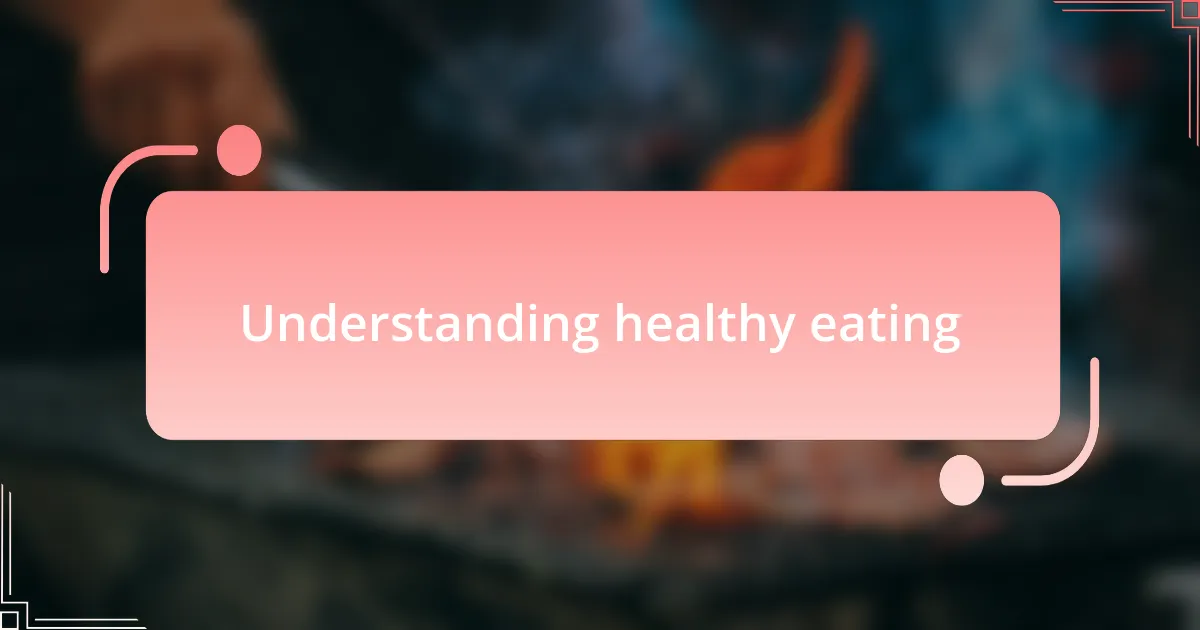
Understanding healthy eating
Healthy eating is not just about counting calories or following strict diets; it’s about tuning into your body’s natural signals and nourishing it in a way that feels right for you. I remember a time when I became overly focused on food restrictions, and it took away my joy and spontaneity around meals. Have you ever noticed how some foods make you feel energized while others leave you sluggish? That’s your body communicating its needs.
When I started embracing intuitive eating principles, I discovered that healthy eating involves listening, reflecting, and adjusting. For instance, there were moments when I craved sweets after a meal, but instead of stifling that urge, I explored why. Was I truly hungry, or was I seeking comfort? This realization transformed my relationship with food, making it less about guilt and more about connection.
Healthy eating should feel empowering rather than restrictive. One day, while enjoying a vibrant salad topped with all my favorite ingredients, I realized how colorful and satisfying it was, both visually and emotionally. What’s your go-to meal that makes you feel energized and happy? Understanding healthy eating is about creating a personal experience that nourishes not just the body, but also the spirit.
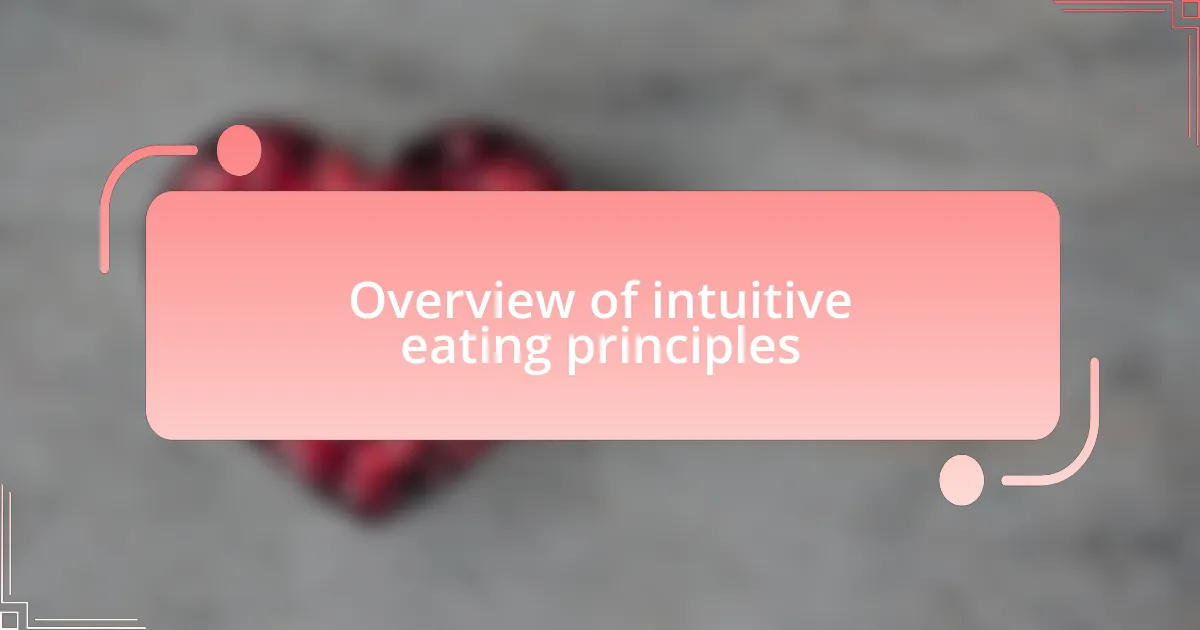
Overview of intuitive eating principles
Intuitive eating is founded on a set of principles that encourage you to get in touch with your body’s internal cues. As I began my journey, I realized it was about honoring hunger and fullness signals rather than adhering to external diet rules. I remember one day staring at half a chocolate bar—tempted to finish it, yet I paused and asked myself if I was genuinely hungry or if I just wanted it because it was there. That moment was enlightening.
Another essential principle emphasizes the importance of embracing all foods without labeling them as “good” or “bad.” I used to view pizza as a guilty pleasure, but once I let go of that notion, I found the experience of sharing a slice with friends became joyful rather than fraught with anxiety. Have you ever felt that weight lift when you allow yourself to enjoy something without shame? It’s a powerful shift.
Lastly, intuitive eating promotes listening to your body’s satisfaction signals. I recall a time when I savored a homemade meal, and halfway through, I realized I was content. Stopping then, rather than finishing out of habit, taught me to appreciate my food and listen closely to what my body craved. This practice of mindfulness around meals fosters a deeper connection to what truly nourishes us.
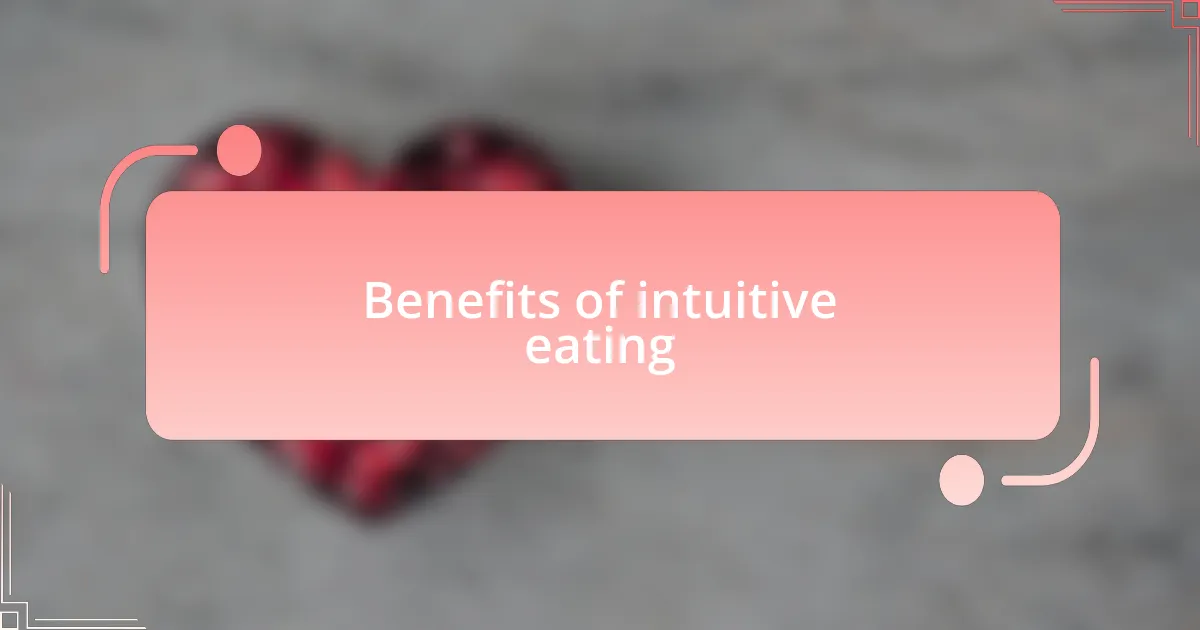
Benefits of intuitive eating
One of the remarkable benefits of intuitive eating is the liberation it brings from chronic dieting. I remember a time when my social life revolved around meal plans and calorie counting, which strained my relationships and made me feel isolated. Can you relate to the stress of planning meals around arbitrary goals rather than enjoying food with friends? Breaking free from those constraints allowed me to enjoy meals and foster connections without the guilt that often accompanied my choices.
Intuitive eating also cultivates a healthier relationship with food over time. Initially, I approached snacks with a sense of dread, constantly worrying about what they meant for my health. However, as I embraced the principle of honoring cravings, I found that indulging in foods I loved, like buttery popcorn during movie nights, didn’t lead to chaos. Instead, it became a meaningful part of my life, creating joyful moments and reducing the desire to binge. Have you ever noticed how guilt can spiral into unhealthy habits?
Furthermore, this approach encourages self-compassion, which I found essential during my journey. There were days when I faced challenges, overeating during stressful periods. But with intuitive eating, rather than berating myself, I learned to understand those moments as part of being human. This mindset shift not only nurtured my mental well-being but fostered resilience, helping me approach setbacks with curiosity rather than shame. Have you ever allowed yourself the grace to learn from your eating experiences? It’s a profound realization that gently guides you back to your journey with kindness.
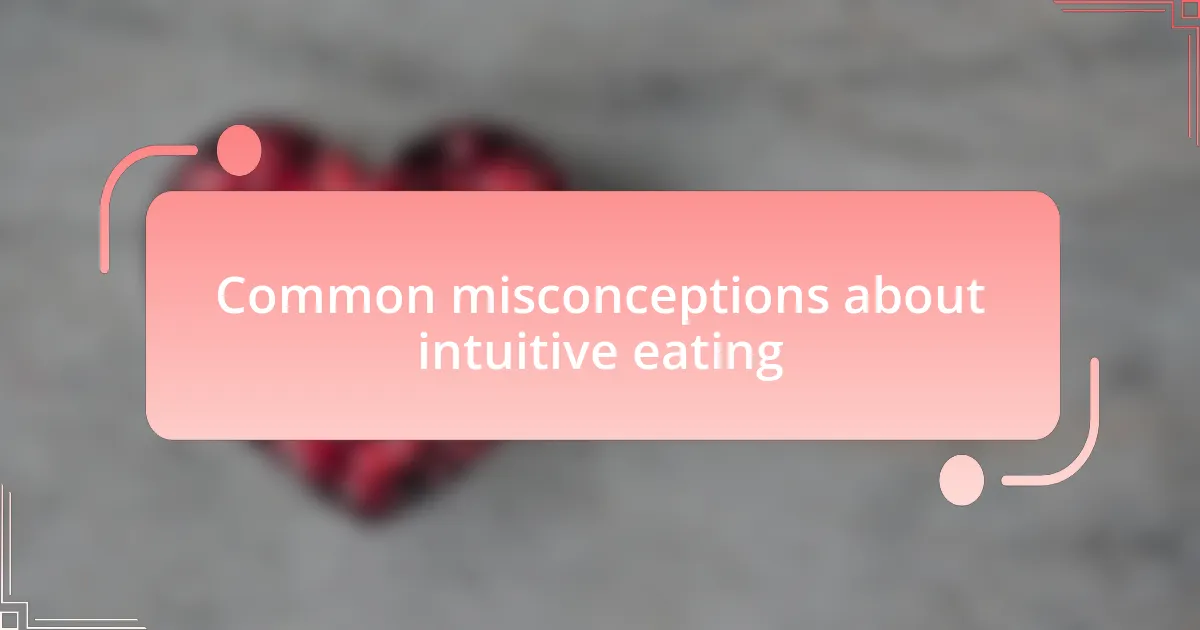
Common misconceptions about intuitive eating
A common misconception about intuitive eating is that it encourages mindless overeating. I used to think this way, fearing that if I listened to my body, I’d lose control and indulge constantly. However, I found that truly tuning into my hunger and fullness cues helped me become more aware of what my body needs, allowing for moderation rather than excess. Have you ever tried to really listen to what your body is telling you?
Another prevalent myth is that intuitive eating means you can eat whatever you want, whenever you want, without any regard for nutrition. Initially, I was convinced that this meant I could indulge in pizza every day. But what I discovered was that when I prioritized nourishing my body, I naturally gravitated toward foods that made me feel good, both physically and emotionally. This balance ended up feeling liberating rather than restrictive. Have you experienced that shift in mindset?
Some people believe that intuitive eating is just a fad or a new trend. I must admit, I was skeptical at first, thinking it couldn’t possibly be a sustainable approach. But as I immersed myself in its principles, I realized this is more about fostering a lifelong relationship with food rather than following the latest diet. It’s about cultivating awareness and understanding, which, as I discovered, brings a profound sense of peace to my eating experiences. How do you view the notion of intuitive eating in relation to your eating habits?
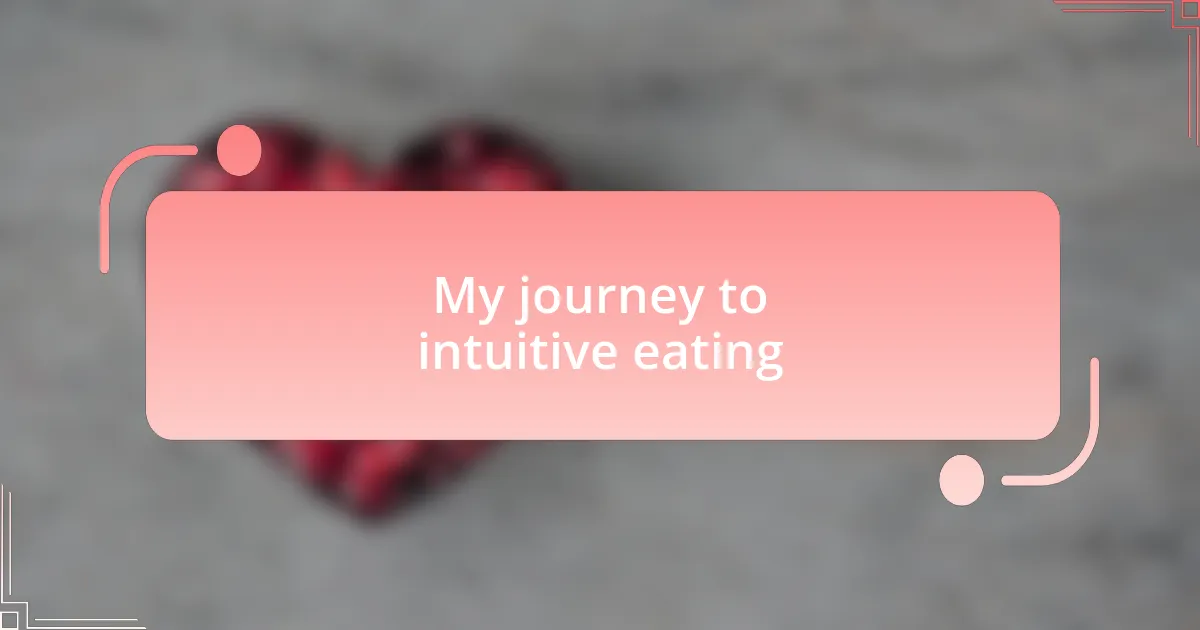
My journey to intuitive eating
Embarking on my journey to intuitive eating was like peeling away the layers of a complicated relationship with food. In the beginning, I constantly questioned my choices, often opting for what I thought I ‘should’ eat instead of what I genuinely craved. It was a challenge to rewire my thinking, especially as I navigated the tension between desire and obligation—have you ever felt frustrated by such inner conflict?
As I learned to listen to my body, I recall a pivotal moment when I savored a piece of chocolate cake. Instead of devouring it mindlessly, I took the time to relish each bite, discovering that it wasn’t just about taste; it was about emotion too. That experience taught me that food isn’t solely a source of fuel but can also serve as a vehicle for joy. Have you found moments where food becomes more than just sustenance for you?
Over time, I began to trust my instincts more, shedding guilt that once shadowed my choices. There was a day I chose a hearty salad simply because my body was asking for something fresh and vibrant. This shift wasn’t just about food; it was a transformation in my mindset. I began to realize that intuitive eating helped me reclaim my body’s wisdom—it empowered me to take charge of my well-being. How has your intuition guided you in making healthier choices?
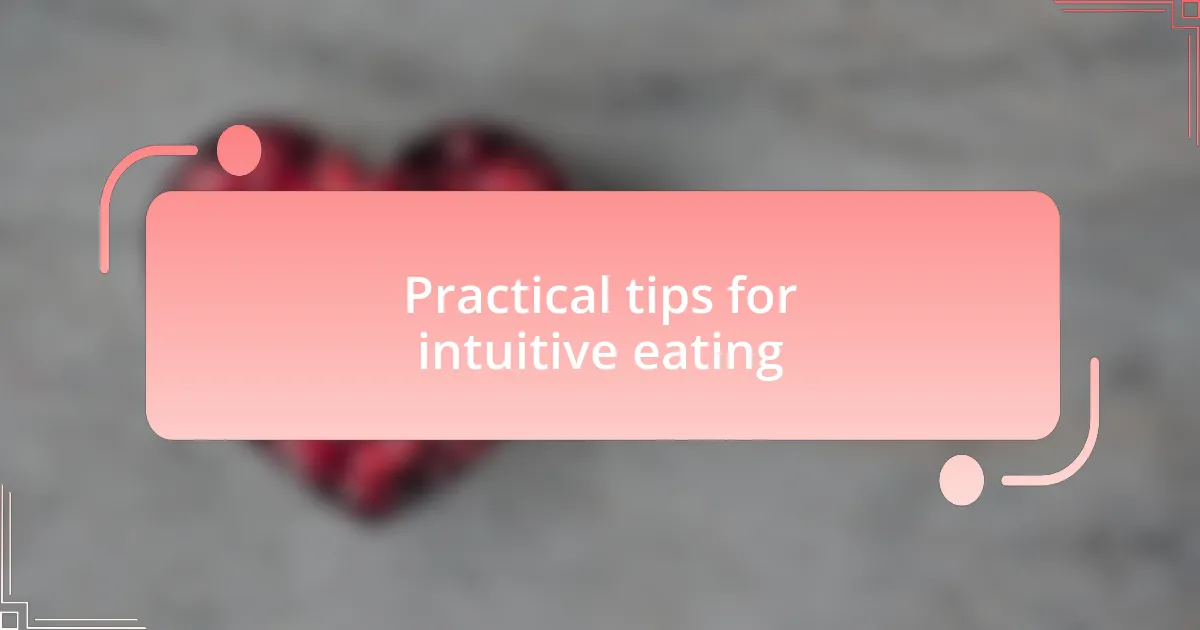
Practical tips for intuitive eating
When it comes to practical tips for intuitive eating, one of the most valuable lessons I’ve learned is to pause before meals. I often ask myself, “What does my body truly need right now?” This simple question has turned into a ritual for me, helping to invite awareness about my hunger levels and food preferences. Sometimes, just a moment of reflection can lead to a satisfying meal that aligns with my cravings.
Another tip I’ve found helpful is to ditch the idea of ‘good’ and ‘bad’ foods. I remember a time when I felt guilty for enjoying fries, even if they were a rare treat. Embracing the notion that all foods can fit into a healthy lifestyle changed everything for me. It allowed me to experience freedom in my choices, taking away the restrictions that often lead to binge feelings. Have you noticed how labeling food can influence your relationship with it?
Lastly, I’ve discovered that mindful eating enhances my intuitive experience. Taking the time to savor each bite, like when I slowly enjoyed a bowl of creamy pasta, made me realize how textures and flavors elevate meals beyond mere sustenance. I now ask, “How does this food make me feel?” Instead of rushing through meals, I relish the experience, which deepens my connection to what I’m eating. What small practices can you integrate into your dining experience?